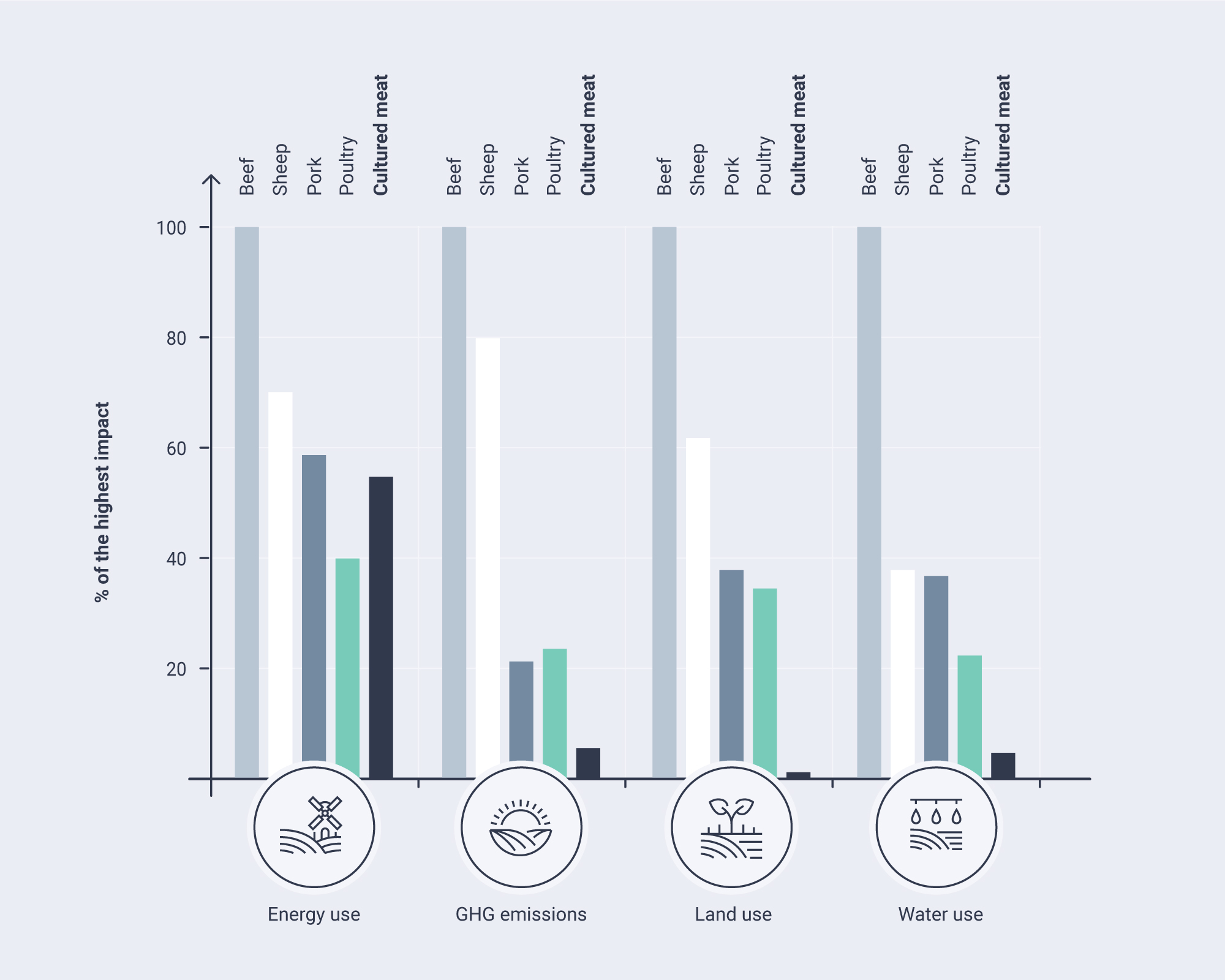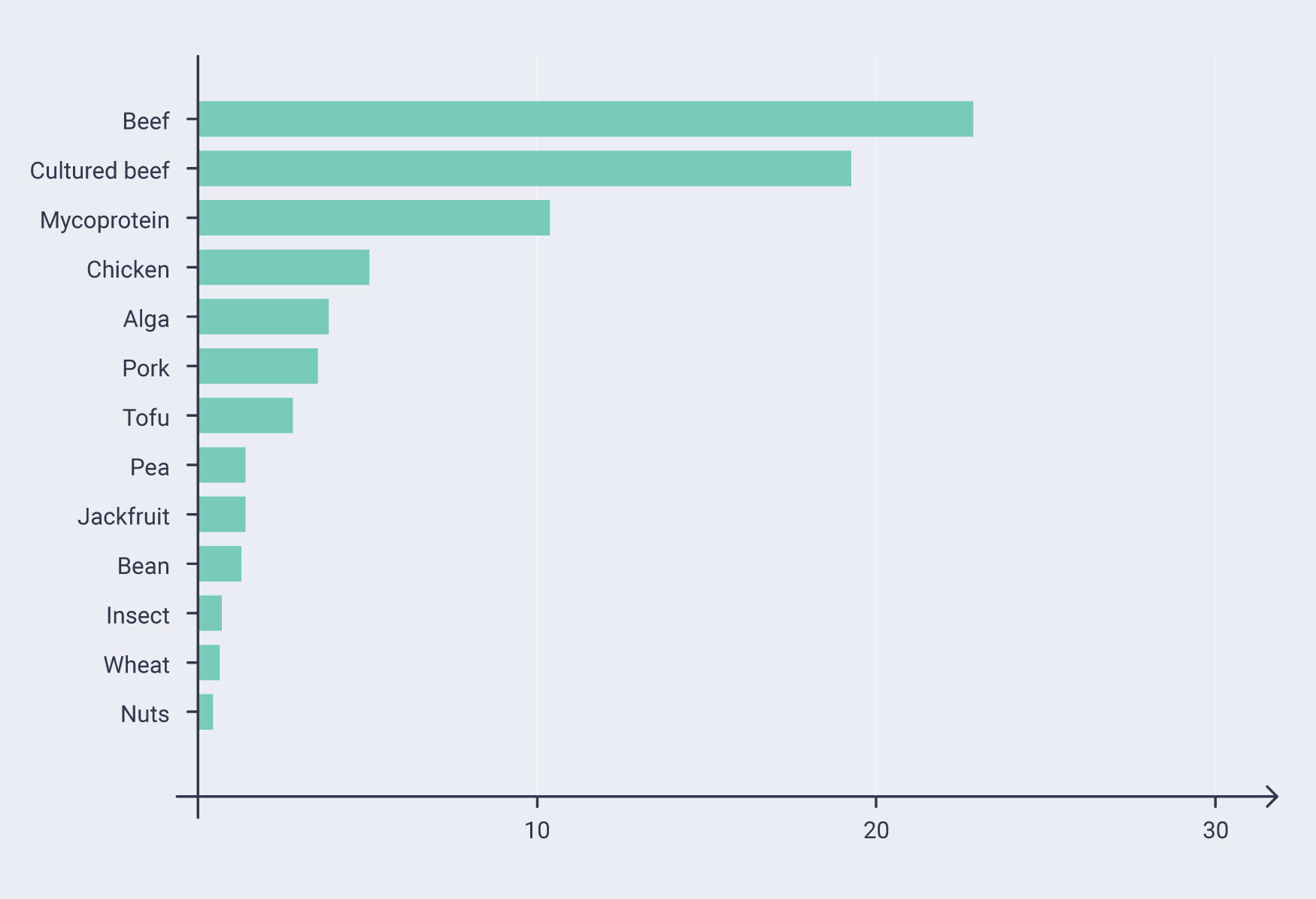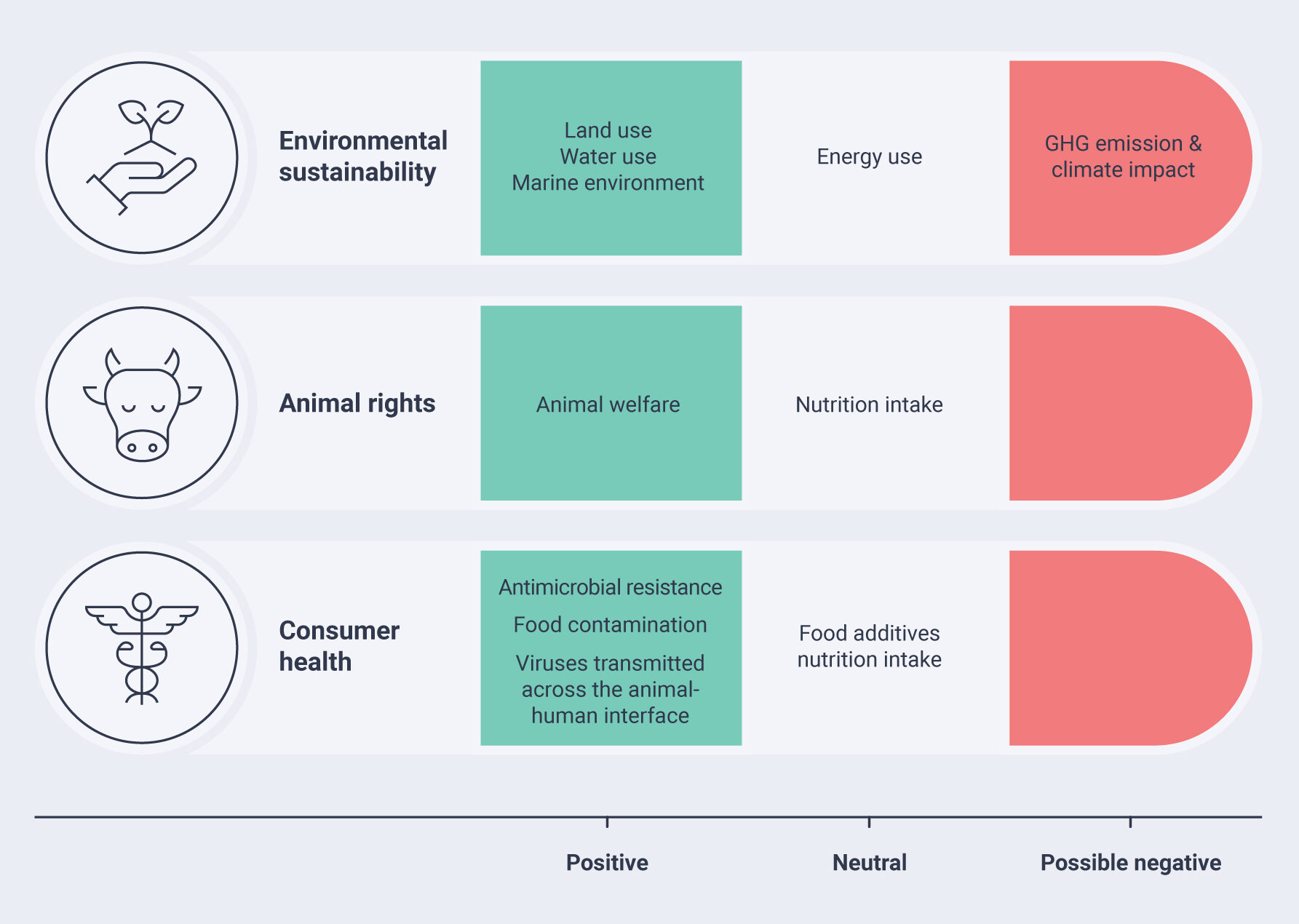Environmental sustainability
Environmental sustainability
The livestock industry is a significant contributing factor to greenhouse gas emissions, pollution, water use, land use, and deforestation. The fishing industry may also affect ecological processes on an enormous scale. The overall impact of fishing on aquatic systems has been described as comparable to that of agriculture on land [46]. In recent years, cultured meat and fish have emerged as novel protein products that have the potential to reduce the damage done by traditional meat and fish production.
Land and water requirements
A widely cited life cycle analysis (LCA) published in July 2011 found that in-vitro meat offered very clear advantages in terms of land and water use when compared to conventionally produced European meat, including beef, sheep, pork, and poultry: “Cultured meat involves approximately 7-45% lower energy use (only poultry has lower energy use), 78-96% lower GHG emissions, 99% lower land use, and 82-96% lower water use depending on the product compared” [47]. The findings in this study demonstrated that cultured meat offers a clear advantage in land and water use, but that its advantages in terms of energy use only apply in comparison to the traditional production of beef and mutton. Also, cell-based meat has lower GHG emissions compared to traditional meat. This significant contribution to the cultivated meat literature has been cited extensively to support the belief that cultured meat will be an environmentally friendly alternative to livestock rearing.
Cultured meat fish can provide similar benefits as the reduced land-use regarding use of the seas. Relieving pressure on depleted fishing grounds could also remove a serious bone of contention between nation-states that have been competing, and occasionally fought wars, over disputed fishery zones and quotas. Examples include the repeated confrontations between the UK and Iceland from the 1950s to the 1970s. More recently, the same issue has been identified as a possible catalyst for the UK’s exit from the EU.
The LCA conducted by Tuomisto and de Mattos in 2011 evaluates the environmental impact associated with all the stages in the life cycle of meat products. One of the main challenges when conducting an LCA for cultured meat is that a commercial-scale process, on which a reliable LCA should be based, is not yet available. As a result, any LCAs relating to the in-vitro meat industry are anticipatory in nature. The Tuomisto and de Mattos study can provide insight into the environmental implications, but should not be regarded as conclusive [48]. In fact, as the next section will discuss, there are several studies that question the supposed advantage of cell-based meat when it comes to energy use and GHG emissions.

Energy requirements
Direct energy input is needed at several stages of cultivated meat production for converting raw biomass material into the cell medium, for the cultivation of the cells, and for processing them into a consumable product, including sterilization and hydrolysis [47].
Cell-based meat does not offer any clear advantage over conventional pork and poultry meat when it comes to energy use, but only in comparison to beef. This suggests that a low-cost and low-carbon source of energy may be a prerequisite for cultured meat to be economically and environmentally viable (some of the energetic shortcomings are addressed in Chapter 6) [49].
However, as Paul Teng and other Supertrends experts have pointed out, given the current small scale of production and the novelty of this technology, it is almost certain that it will become more energy-efficient with further development.
Greenhouse gas emissions and climate impact
Livestock production systems, especially beef cattle, are associated with a number of GHG emission types and are significant drivers of climate change. Carbon cycle models show that direct livestock emissions were responsible for 23 percent of Earth’s total modelled warming in 2010 [50].
While Tuomisto and de Mattos (2011) found that in-vitro meat caused 78-96 percent less GHG emissions compared to conventional meat, a 2019 World Economic Forum report suggested that the GHG emissions of cultured beef may be only 7 percent lower than traditional beef (see table below). The estimates for emissions of cultured beef in the latter report were based on research done by Smetana et al. in 2015 using a standard Life Cycle Assessment (LCA) approach. The differences between the two studies are due to the inclusion of additional stages and resources (transportation, frying, and cooling at consumer) in the LCA of the 2015 study. The Tuomisto de Mattos (2011) study relied on a product from cradle (feed or raw material production) to processor gate as their LCA approach, and the Smetana et al (2015) study relied on a product from cradle (feed or raw material production) to plate (cooking at the consumer). The analysis indicated that frying at consumer was, on average, responsible for about 33 percent of the environmental impact [51]. This part of the environmental impact was not considered in the Tuomisto de Mattos (2011) study [52].

Another recent study suggests that cultivated meat emissions consist almost exclusively of CO2 from energy generation, while cattle farming is associated with the production of three GHGs – carbon dioxide (CO2), methane (CH4), and nitrous oxide (N2O). The concern is that while CH4 emissions on average only stay in the atmosphere for 12 years, CO2 and N2O stay much longer (it is estimated that between 65 percent and 80 percent of CO2 released into the air dissolves into the ocean over a period of 20–200 years, and that N2O stays in the air for ca. 114 years). This means that emissions from farming can have lasting impact on global warming [53].
Recent studies call into question the perceived benefits of cultured meat in reducing GHG emissions and climate change. The matter may not be resolved until the technology, which is still very much in its infancy, is scaled up and its energy efficiency improves. If this happens, cell-based meat certainly has the potential to have a substantial positive impact in mitigating climate change.
There could also be a reduction in secondary pollution from ground transportation and shipping, since meat could be produced closer to the consumer. That means that the technology of cell-based protein provided opportunities for countries that are not traditionally suited for producing livestock, such as Singapore, to set up their own meat production. Indeed, Supertrends experts Matthew Anderson-Baron and Carrie Chan have predicted that the cultivated meat industry would cause decentralization in meat production. In 20 years, we could see many major cities producing cultured meat and fish in their suburbs. With meat production taking place more locally, the need to transport meat, fish, and livestock will be reduced.
Finally, if implementation of cultivated meat leads to reforestation, then this process can lead to a carbon-sink effect that reduces greenhouse gas effects.
Marine environment
Overfishing and some new technologies used in the fishing industry have been identified as primary causes of ecosystem collapse in many aquatic systems. Some species have been overfished to the point of near-extinction. Besides directly depleting fish stocks, the fishing industry leads to changes in the structure of marine habitats and influence the diversity, composition, biomass, and productivity of the associated biota [54]. Cultured fish and seafood clearly offer an alternative to fishing and a possible way of repairing the environmental damage caused by the fishing industry.
Animal welfare
Animal welfare
At a time when billions of animals are reared in industrial conditions in order to produce meat, animal welfare and suffering are gaining increased attention. Conscious experience exists not only in human beings, but also in animals [55]. EU legislation officially recognizes animal sentience and their capacity to suffer. Intensive animal farming is inescapably associated with systematic disregard for their welfare.
Maintaining the wellbeing of animals is often time-consuming, yet not strictly necessary for the production of meat at an affordable level. On the other hand, high market demand for meat results in farmers striving to make all aspects of production more cost-effective. The result is that animal welfare measures are commonly reduced to an absolute minimum or, in some cases, largely ignored in factory farms [56];[57];[58].
In the early stages of the cultured meat industry, stem cells and serum were derived from animal sources. The extraction of fetal bovine serum from live fetuses is a particularly controversial practice that the cell-based meat industry has worked hard to eliminate. Leading cultivated meat researcher Mark Post has been quoted as saying: “We will never market a product that needs calf serum to produce it” [59].
Cultured meat makes the raising and killing of animals for food unnecessary. From an animal protection perspective, this could appeal to [...] vegetarians, and to those conscientious omnivores who are interested in reducing their meat intake on ethical grounds [60].
Health
Health
The main benefits of cultured meat for human health are food safety, the ability to fine-tune and optimize nutrient intake through additives, and the ability to provide a more protein-rich diet to a larger percentage of the global population.
Food safety
Producing meat synthetically in carneries could also spell the end of “wet markets”, where fresh meat and fish as well as live animals come into close contact with humans, and which are potential hot spots for bad hygiene and zoonotic diseases.
In recent years, public concern about the safety of food originating from animals has been heightened due to problems directly related to the industrialization of animal husbandry, such as bovine spongiform encephalopathy (BSE), dioxin contamination, and viruses transmitted across the animal-human interface (as suspected with COVID-19), as well as veterinary drug residues and antimicrobial resistance in microorganisms.
Cleaner means safer
Cell-based meat, also called “clean meat”, is produced in sterile bioreactors. This offers the promise of laboratory-level control of the whole process. cultured meat offers benefits for food safety on several levels.
- By bypassing the whole animal, it can eliminate contaminations with common pathogens (such as Salmonella or E. coli) and harmful chemicals (such as dioxin).
- By bypassing the human-animal interface completely, cultured meat helps to prevent the transmission of viruses via this pathway.
- By eliminating the use of antibiotics and vaccination, cultivated meat offers both economic and health benefits, since the use of antibiotics in veterinary medicine is one important reason for the spread of antimicrobial resistance.
Nutrient intake
The exact nutrition data of in-vitro meat is not yet available, though as a product directly derived from meat, cell-based meat should have similar levels of macronutrients such as carbohydrates, lipids, and proteins that provide energy.
It has been suggested that the nutrient content of cultured meat can be controlled by adjusting fat composites used in the medium of production, such as the ratio between saturated fatty acids and polyunsaturated fatty acids. Saturated fats can also be replaced by healthier fats, such as omega-3 [61]. At this time, the potential nutritional benefits outlined above remain unproven.
Controversy over micrunotrients
The main argument relates to the aspect of micronutrients. So far, no study has been done on the presence of certain micronutrients specific to animal products (such as vitamin B12 and iron) in in-vitro meat and whether the positive effect of any (micro-) nutrient can be enhanced [61].
On another note, in an interview with Supertrends, Avant Meats co-founder Carrie Chan cited an additional potential benefit of cultured fish: Good quality collagen for skin anti-aging substances could be obtained as a by-product of the manufacturing process.
Other benefits
Other potential advantages of cultured meat include:
- Waste reduction, since the process is optimized for producing only the meat required for human consumption.
- Consistent access to protein for a greater share of the global population, since cultivated meat has a smaller footprint in terms of climate, land quality, and area.
- The substitution of certain high-yield, hybridized breeds of livestock with the more traditional livestock that can thrive in low-density, low-input, extensive systems [62].
- The ability to offer meat from rare species.
Cultured meat is presented today as a high-tech product that has the potential to be both ecologically and morally sustainable. Since the technology is still in its infancy, it is difficult to make predictions based on the current small scale of production and limited data, and so much of the present research does not reflect the impact it may have when produced on a large scale.
Health vs. competitiveness
In-vitro meat can only compete with traditional meat on the world market if it is affordably priced for consumers and profitable for producers, which requires high-volume, low-cost production techniques.
Will the impacts on health and the environment still be taken into consideration when production is increased to industrial scale? If that question can be answered positively, many benefits mentioned above can be materialized. The determination to make our world more sustainable, which has been the motivation that drove many entrepreneurs to found cultivated meat start-ups, will remain as the core value of the in-vitro meat industry.
Takeaways
Takeaways
Cultivated meat has a broad range of potential benefits in many areas: While global land use for farming has been roughly unchanged since the 1980s, despite a significant rise in food production, it has stabilized at a very high and thus damaging level. For instance, 40 percent of the US landmass are used for grazing and growing animal feed. Adoption of cultured meat could free up virtually all of this land for leisure areas and national parks.
The fishing industry has a similar effect on aquatic systems as agriculture does on land. Reducing fishing will improve natural sea fauna and reduce conflicts over fishing rights.
In-vitro meat can boost animal welfare and reduce emissions associated with animal hubandry, which is responsible for close to one quarter of global GHG. Renaturalized farmlands can serve as powerful carbon sinks.
Widespread consumption of cultured meat can reduce overuse of antibiotics, food contamination, and the spread of zoonotic diseases while increasing food security and autarky, especially in Africa and South America. The technology allows the production of healthier, more diverse, and more nutritious meat products with a lower input of energy.
Compared to traditional meat, the main benefits of cultured meat as cited by its advocates are environmental sustainability, animal welfare, and consumer health. Cell-based meat does not presently offer any clear advantages when it comes to energy consumption, food additives, and nutrients. Recent research has found that cultivated meat could have a negative impact in terms of greenhouse gas emissions and climate impact .

References
[46] Garcia, S. M. et al. 2003. The ecosystem approach to fisheries. Issues, terminology, principles, institutional foundations, implementation and outlook. FAO Fisheries Technical Paper 443.
[47] Tuomisto, H. and M. Teixiera de Mattos 2011. Environmental impacts of cultured meat production. Environmental Science and Technology 45(14):6117–23
[48] Mattick, C. et al. 2015. A case for systemic environmental analysis of cultured meat. ScienceDirect 14(2): 249-254
[49] Reisinger, A. and H. Clark 2018. How much do direct livestock emissions actually contribute to global warming? Global Change Biology 24(4):1749-61.
[50] Smetana, S. et al. 2015. Meat Alternatives: Life cycle assessment of most known meat substitutes. The International Journal of Life Cycle Assessment 20(9):1254–67
[51] “World Employment and Social Outlook – Trends 2018” n.d., 82:50.
[52] Lynch, J.M. and R. Pierrehumbert 2019. Climate impacts of cultured meat and beef cattle. Frontiers in Sustainable Food Systems 3:5.
[53] Jennings, S. and M.J. Kaiser 1998. The effects of fishing on marine ecosystems. Advances in Marine Biology 34:201–12.
[54] Griffin, D. and Speck, G. 2004. New evidence of animal consciousness. Animal Cognition, 7(1):5–18.
[55] Humane Society of the United States (HSUS) 2010. An HSUS report: The welfare of animals in the meat, egg, and dairy industries. Technical report, Humane Society of the United States.
[56] HSUS 2010. An HSUS report: The welfare of animals in the pig industry. Technical report, Humane Society of the United States
[57] HSUS 2012. An HSUS report: The welfare of intensively confined animals in battery cages, gestation crates, and veal crates. Technical report, Humane Society of the United States.
[58] Marx, P. in collaboration with C2W 2018. On our way to animal-free cultured meat. C2W International 5 (2018). https://c2winternational.nl/2018-05/on-our-way-to-animal-free-cultured-meat/
[59] Hopkins, P. and A. Dacey 2008. Vegetarian Meat: Could technology save animals and satisfy meat eaters? Journal of Agricultural Ethics 21(6):579–96
[60] Chriki, S. and J.-F. Hocquette 2020. The myth of cultured meat: A review. Frontiers in Nutrition 7:7. https://doi.org/10.3389/fnut.2020.00007.
[61] Stephens, N. et al. 2018. Bringing cultured meat to market: Technical, socio-political, and regulatory challenges in cellular agriculture. Trends in Food Science & Technology 78:155–66.
[62] Lautenschlaeger, R. and M. Upmann 2017. How meat is defined in the European Union and in Germany. Animal Frontiers 7(4):57–9.
